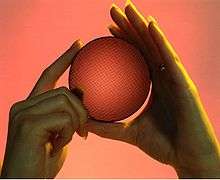
Katana
Historically, katana (刀) were one of the traditionally made Japanese swords (日本刀, nihontō) that were used by the samurai of feudal Japan. Modern versions of the katana are sometimes made using non-traditional materials and methods. The katana is characterized by its distinctive appearance: a curved, slender, single-edged blade with a circular or squared guard and long grip to accommodate two hands.
History
The production of swords in Japan is divided into specific time periods:
The first use of "katana" (gatana) as a word to describe a long sword that was different from a tachi occurs as early as the Kamakura Period (1185–1333). These references to "uchigatana" and "tsubagatana" seem to indicate a different style of sword, possibly a less costly sword for lower-ranking warriors. The evolution of the tachi into the katana seems to have started during the early Muromachi period (1337 to 1573). Starting around the year 1400, long swords signed with the "katana" signature were made. This was in response to samurai wearing their tachi in what is now called "katana style" (cutting edge up). Japanese swords are traditionally worn with the signature facing away from the wearer. When a tachi was worn in the style of a katana, with the cutting edge up, the tachi's signature would be facing the wrong way. The fact that swordsmiths started signing swords with a katana signature shows that some samurai of that time period had started wearing their swords in a different manner.
Katana (disambiguation)
Katana is Japanese for backsword and often refers to uchigatana, especially in English. For a list of fictional katana, see Katanas in fiction. Katana may also refer to:

Dreamcast
The Dreamcast (Japanese: ドリームキャスト, Hepburn: Dorīmukyasuto) is a home video game console released by Sega on November 27, 1998 in Japan, September 9, 1999 in North America, and October 14, 1999 in Europe. It was the first in the sixth generation of video game consoles, preceding Sony's PlayStation 2, Nintendo's GameCube and Microsoft's Xbox. The Dreamcast is Sega's final home console, marking the end of the company's 18 years in the console market.
In contrast to the expensive hardware of the unsuccessful Sega Saturn, the Dreamcast was designed to reduce costs with "off-the-shelf" components, including a Hitachi SH-4 CPU and an NEC PowerVR2 GPU. Released in Japan to a subdued reception, the Dreamcast enjoyed a successful U.S. launch backed by a large marketing campaign, but interest in the system steadily declined as Sony built hype for the upcoming PlayStation 2. Sales did not meet Sega's expectations despite several price cuts, and the company continued to incur significant financial losses. After a change in leadership, Sega discontinued the Dreamcast on March 31, 2001, withdrawing from the console business and restructuring itself as a third-party publisher. 9.13 million Dreamcast units were sold worldwide.

Catalysis
Catalysis (/kəˈtælᵻsᵻs/) is the increase in the rate of a chemical reaction due to the participation of an additional substance called a catalyst (/ˈkætəlᵻst/). With a catalyst, reactions occur faster and require less activation energy. Because catalysts are not consumed in the catalyzed reaction, they can continue to catalyze the reaction of further quantities of reactant. Often only tiny amounts are required.
Technical perspective
In the presence of a catalyst, less free energy is required to reach the transition state, but the total free energy from reactants to products does not change. A catalyst may participate in multiple chemical transformations. The effect of a catalyst may vary due to the presence of other substances known as inhibitors or poisons (which reduce the catalytic activity) or promoters (which increase the activity). The opposite of a catalyst, a substance that reduces the rate of a reaction, is an inhibitor.
Catalyzed reactions have a lower activation energy (rate-limiting free energy of activation) than the corresponding uncatalyzed reaction, resulting in a higher reaction rate at the same temperature and for the same reactant concentrations. However, the detailed mechanics of catalysis is complex. Catalysts may affect the reaction environment favorably, or bind to the reagents to polarize bonds, e.g. acid catalysts for reactions of carbonyl compounds, or form specific intermediates that are not produced naturally, such as osmate esters in osmium tetroxide-catalyzed dihydroxylation of alkenes, or cause dissociation of reagents to reactive forms, such as chemisorbed hydrogen in catalytic hydrogenation.
Catalyst (disambiguation)
A catalyst is a substance which increases the rate of a chemical reaction.
Catalyst may also refer to:
Buildings
Economics and finance
Events
Media and entertainment
Games
Literature and publications
Catalyst (TV program)
Catalyst is the ABC's primary science journalism television series and the only science show on primetime television in Australia. Launched in 2001, it replaced Quantum, which had ceased the previous year. Catalyst is regularly broadcast on ABC 1 at 8:00 pm on Tuesdays and at 11:30 am Saturdays. Also repeated on ABC News 24 on Saturdays at 4:30 pm.
Catalyst celebrated its tenth year of production in 2010.
Description
The show broadcasts stories on scientific themes, and in particular significant recent developments and discoveries. It focuses primarily on stories relevant to Australia, but the series covers international developments as well. It attempts to convey information in a way that is not only accurate but also interesting and informative to the general population, often discussing the ethical, political, and other implications of scientific discoveries and research as well as the discoveries themselves.
The show's website describes it as follows:
Each week Catalyst brings you stories from Australia and around the world.
Podcasts:

